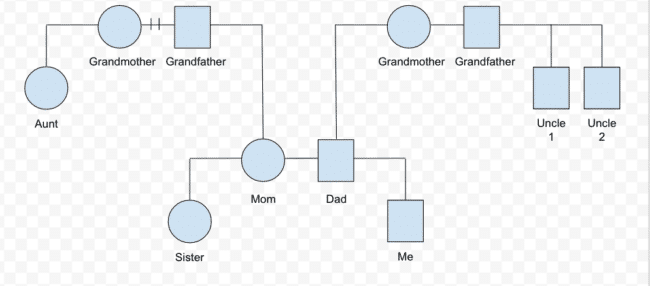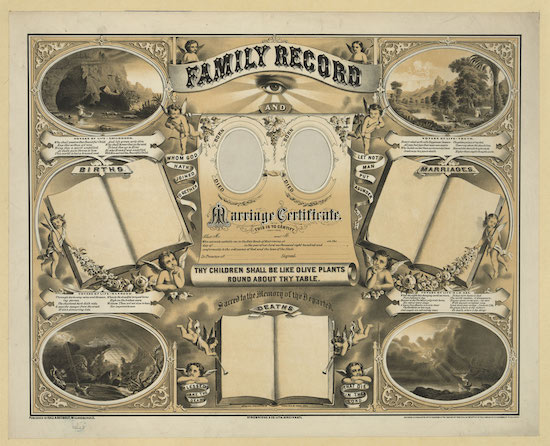Editor’s note: This is a guest article from AJ Gretz.
Learning about your family can be an interesting, emotional, and sometimes difficult process. Every family has a story. Some parts will leave you proud, and perhaps even inspired to pursue greater virtue and generosity.
Others, maybe not so much.
If you’ve begun researching your family history, you might be looking for a way to assimilate all of the information you’re learning in a meaningful way. This is where creating a family genogram can be extremely helpful.
What Is a Genogram?
A genogram is essentially an enhanced version of the family tree. To start, you map out your family history, going back two or three generations (or more if you feel really ambitious). However, rather than simply recording the historical facts about your family, you also note patterns of behavior, and the quality of relationships between different family members.
I was first introduced to the concept of the genogram when I was in seminary. As part of a class my first year, we were asked to compile a genogram as a way of better understanding our own family history. My professor explained that if we know where we come from, and the particular issues and temptations that have affected our relatives, we can more easily identify and overcome those same issues ourselves.
Genograms are often used by counselors and therapists with an interest in what’s called Family Systems Theory. In a nutshell, Family Systems Theory is a way of understanding individuals as part of a larger family “system.” FST argues that evaluating a person only as an individual — outside their upbringing and family life — misses key information about them. This is because the more anxiety and conflict there is in a person’s family system, the more likely it is that they have been adversely affected by the people around them.
Genograms are useful because they help to unpack family dynamics, some of which have been in play for decades. The way your parents treated you was largely influenced by the way their parents treated them, just as your grandparents were shaped by the way their parents treated them, and so on.
Understanding the history (and sometimes, dysfunction) of your family can be a powerful opportunity for personal growth. The more we understand how we have been shaped by the network of personalities and relationships that we’ve grown up with, the more we can identify what we want to hold on to, and what we want to change.
How to Make a Family Genogram
Genograms typically use different symbols as shorthand to depict both the individuals in a family system, and the nature of their relationships with one another.
For example, males are often drawn as squares, and females as circles. Children are indicated through a connected solid line, usually below the names of their parents.
Here is an illustration of an immediate family:

Now let’s add aunts and uncles, as well as grandparents. We can also use different symbols to explain some of the relationships. Healthy relationships are marked with the solid line. Divorce can be shown with two slashes on the line:

Tracking Traits
One of the things you can do with a family genogram is track how certain personality traits or talents have been passed through your family line.
For example, perhaps you are a musician, and in the process of talking with family members, you realize musical ability (indicated with “M” below) runs throughout your family tree:

Or, perhaps you are looking for whether or not alcohol or a certain prescription medication is something you want to consume. Looking at your family history may help you understand that you could be predisposed towards certain substance abuse addictions (indicated with “SA” below) or other unhealthy vices:

Tracking Relationships
Any conflict that you want to note between family members can be marked by a squiggly line, rather than a solid one. For example, perhaps there has been ongoing conflict on your father’s side between between your father and grandfather. In the genogram, you would want to note this, and indicate your understanding of the conflict:

It is sometimes (though certainly not always) the case that these conflicts, if not dealt with, re-appear down the family line. As you flesh out the genogram, you may begin to notice patterns:

Doing the genogram and talking with family members can help you understand the root of this conflict, which will both promote healing in your own family system, and help guard you against falling into the same issues.
In the above example, it is possible that the grandfather had a poor relationship with his father. This has created a chain of conflict among the men in the family. Recognizing this pattern would help an individual see his conflict with his father as part of a larger, systemic issue. If the man can begin to understand his father, and why his father’s relationship with his father is so poor, there may be an opportunity for improvement in the relationship.

Another possibility is that this systemic conflict is the result of a divorce that did not end well. Some studies have shown that children of divorced parents have a greater risk of getting divorced themselves (called the “intergenerational transmission of divorce”). In this family system, neither the grandfather nor his children have ever really dealt with their pain and disappointment. And without doing the hard work of healing and forgiving, this conflict has had a negative affect on the children, as well as their own marriages.
There are many other possible reasons for this conflict. Abuse, mental illness, substance abuse, workaholic tendencies, etc. all can have a lasting impact on a family system. Doing a genogram is not a magic bullet to solving these problems; it does, however, present an opportunity for personal growth. By better understanding where members of your family are coming from, and what they have dealt with, you may grow in empathy for them, making healing and reconciliation easier.
Genograms can also be helpful if you have a blended family, step-parents, and/or half-siblings as a result of divorce and re-marriage. Understanding these networks of relationships, and the things that have shaped them, can shed light on your own place in the family system. You can do separate genograms for different family “units,” or put them all together to get a sense of the whole system around you.
Filling Out the Genogram — Family Interviews
Once the basic nature of the relationships have been noted, it’s time to get even more detailed information.
For my own class assignment, I was required to interview my immediate family, as well as any extended family I wished to talk to. The goal was to get family members to talk about things that they might not otherwise bring up on their own. And so we were encouraged to intentionally ask questions about their life growing up, and the nature of their relationships with other family members.
Some sample questions you might want to ask family members could be:
- What do you remember about growing up?
- What did you like about the way your parents raised you?
- What did you dislike about the way your parents raised you?
- How did you meet your spouse?
- If divorced, what led to that happening?
- Were you close to your siblings growing up? Why or why not?
- Do you feel close to your siblings now? Why or why not?
- What would it take to have a better relationship with your parents? Or your siblings?
- How do you feel about the way you parented me?
- What do you remember about me as a child?
As you can see, some of these questions are far more personal than others, and there’s high potential for getting into a very serious or sensitive conversation. I had the luxury of telling my family members that I was doing “homework,” which probably let me ask questions more directly than if I was having a casual conversation. You will obviously have to gauge how appropriate it is to ask about certain things, and how willing a family member is to open up about different parts of their own past.
Still, it’s worth risking a little awkwardness in order to understand your family story. I was in my mid-20s when I put together my family genogram, and I was amazed at the things I learned about my family. Although there is pain in my extended family story, I walked away with a newfound respect for my parents. They had dealt with challenges and had experiences I did not know about, and I’m not sure if they would have voluntarily talked about them. Hearing their stories helped to put some of my own personality and experiences into context.
Again, a genogram doesn’t only have to be about the hard stuff. Creating a genogram that tracks certain skills or virtues throughout your family history can help bolster a sense of pride and belonging, as you recognize the impact your family has left on the lives of others. Additionally, a genogram can be a helpful tool to examine your family’s medical history. Recognizing patterns can help you understand your genetic makeup, and how to best take care of yourself over the long haul.
If you’re looking to get started, there are several websites that can help you draw out your family story. I drew these examples using Google Drawing, but there are programs that will do the shapes and connections for you. You can find several of them, as well as a more extensive overview of genograms here.
__________________
AJ Gretz is a pastor, husband, and father of two. He is an advocate for simpler living and a passionate defender of the American Midwest. He and his family currently live in the glorious state of Michigan.



